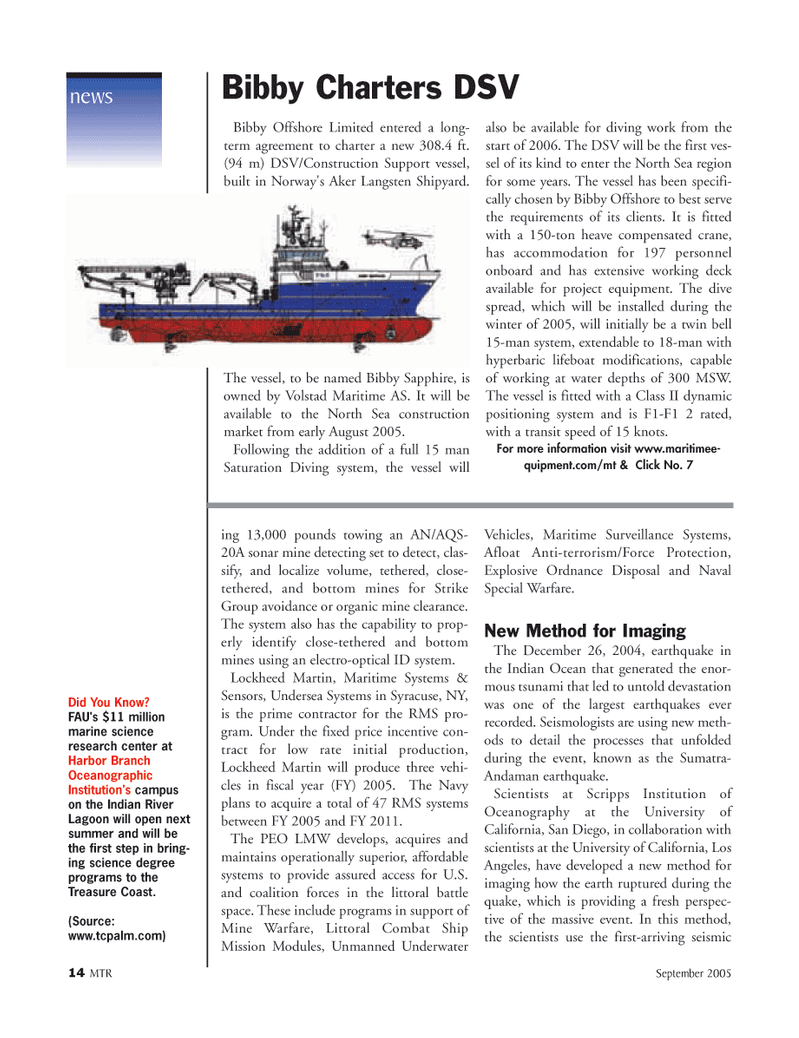
Page 14: of Marine Technology Magazine (September 2005)
Maritime Security & Undersea Defense
Read this page in Pdf, Flash or Html5 edition of September 2005 Marine Technology Magazine
14 MTR September 2005 ing 13,000 pounds towing an AN/AQS- 20A sonar mine detecting set to detect, clas- sify, and localize volume, tethered, close- tethered, and bottom mines for Strike
Group avoidance or organic mine clearance.
The system also has the capability to prop- erly identify close-tethered and bottom mines using an electro-optical ID system.
Lockheed Martin, Maritime Systems &
Sensors, Undersea Systems in Syracuse, NY, is the prime contractor for the RMS pro- gram. Under the fixed price incentive con- tract for low rate initial production,
Lockheed Martin will produce three vehi- cles in fiscal year (FY) 2005. The Navy plans to acquire a total of 47 RMS systems between FY 2005 and FY 2011.
The PEO LMW develops, acquires and maintains operationally superior, affordable systems to provide assured access for U.S. and coalition forces in the littoral battle space. These include programs in support of
Mine Warfare, Littoral Combat Ship
Mission Modules, Unmanned Underwater
Vehicles, Maritime Surveillance Systems,
Afloat Anti-terrorism/Force Protection,
Explosive Ordnance Disposal and Naval
Special Warfare.
New Method for Imaging
The December 26, 2004, earthquake in the Indian Ocean that generated the enor- mous tsunami that led to untold devastation was one of the largest earthquakes ever recorded. Seismologists are using new meth- ods to detail the processes that unfolded during the event, known as the Sumatra-
Andaman earthquake.
Scientists at Scripps Institution of
Oceanography at the University of
California, San Diego, in collaboration with scientists at the University of California, Los
Angeles, have developed a new method for imaging how the earth ruptured during the quake, which is providing a fresh perspec- tive of the massive event. In this method, the scientists use the first-arriving seismic
Bibby Charters DSV news
Bibby Offshore Limited entered a long- term agreement to charter a new 308.4 ft. (94 m) DSV/Construction Support vessel, built in Norway's Aker Langsten Shipyard.
The vessel, to be named Bibby Sapphire, is owned by Volstad Maritime AS. It will be available to the North Sea construction market from early August 2005.
Following the addition of a full 15 man
Saturation Diving system, the vessel will also be available for diving work from the start of 2006. The DSV will be the first ves- sel of its kind to enter the North Sea region for some years. The vessel has been specifi- cally chosen by Bibby Offshore to best serve the requirements of its clients. It is fitted with a 150-ton heave compensated crane, has accommodation for 197 personnel onboard and has extensive working deck available for project equipment. The dive spread, which will be installed during the winter of 2005, will initially be a twin bell 15-man system, extendable to 18-man with hyperbaric lifeboat modifications, capable of working at water depths of 300 MSW.
The vessel is fitted with a Class II dynamic positioning system and is F1-F1 2 rated, with a transit speed of 15 knots.
For more information visit www.maritimee- quipment.com/mt & Click No. 7
Did You Know?
FAU's $11 million marine science research center at
Harbor Branch
Oceanographic
Institution's campus on the Indian River
Lagoon will open next summer and will be the first step in bring- ing science degree programs to the
Treasure Coast. (Source: www.tcpalm.com)
MTR#2 (1-16).qxd 8/30/2005 4:47 PM Page 16

 13
13

 15
15
